#Analog Multimeter
Explore tagged Tumblr posts
Text
Multimeters, Soldering & Electronics Tools | LST Tool
At LST Tools, get trusted Aneng multimeter models, multimeters and premium solder ideal for both professionals and students. Our dependable tools provide accuracy every time whether you're working on a project or fixing electronics.
0 notes
Text

Shop Digital Multimeter and Analog Multimeter
Explore branded True RMS digital multimeters and analog multimeters at Tomson Electronics. Get accurate measurements and reliable performance for your electronic projects. Shop now for top-quality multimeters from trusted brands.
#Digital Multimeter#Analog Multimeter#electronic components online store#electronics#electronic projects#diy projects
0 notes
Text
Analog Multimeters Market is Set To Fly High in Years to Come
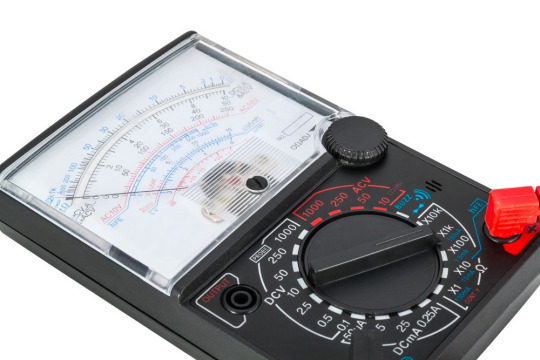
The Latest research coverage on Analog Multimeters Market provides a detailed overview and accurate market size. The study is designed considering current and historical trends, market development and business strategies taken up by leaders and new industry players entering the market. Furthermore, study includes an in-depth analysis of global and regional markets along with country level market size breakdown to identify potential gaps and opportunities to better investigate market status, development activity, value and growth patterns. Access Sample Report + All Related Graphs & Charts @: https://www.advancemarketanalytics.com/sample-report/15525-global-analog-multimeters-market
Major & Emerging Players in Analog Multimeters Market:- Shanghai YiHua (China), Simpson (United States), Tecpel (China), Triplett (England), Circutor (Spain), GOSSEN METRAWATT (Germany), HIOKI E.E. (China), Iskra (Slovenia), Kyoritsu (China), Sanwa Electric Instruement (United States). The Analog Multimeters Market Study by AMA Research gives an essential tool and source to Industry stakeholders to figure out the market and other fundamental technicalities, covering growth, opportunities, competitive scenarios, and key trends in the Analog Multimeters market. Analog multi-meters are the instruments which basically used for electrical testing such as to measure voltage, current, resistance and signal power. One of the best application of the analog multi-meter is that it identifies the electronic and electrical problems. Advanced analog multi-meter comes with more features like capacitor, diode and IC testing modes. Analog multi-meter is PMMC meter it works on principle called Permanent Magnetic Moving Cell (PMMC). Basic function is measurement of resistance in Ohms, Current in Amperes and Potential in Volts. DC Current , AC current , DC Voltage are some specific measurement done with the help of analog multi-meters.
Jewel instrument announced acquisition of Gem Electronics in 2017. The addition of Gem Electronic, Inc.’s consumable products along with Triplett’s growing sales and product development team will better position Triplett to provide a more complete line of solutions for low voltage installers and maintainers. The titled segments and sub-section of the market are illuminated below: by Type (Portable Multimeter, Desktop Multimeter, Hand –held Multimeters, Bench Top Multimeters), Application (Electronic Factories, Laboratories, Residential) Market Trends: Introduction To New Electrical Technologies like Electrical Motor-Cycle
Analog Multi-meters with Rechargeable Batteries are Growing
Opportunities: Adoption Of Various Electrical Devices
Market Drivers: High Need Of Electrical Device Stability
Easily Available in market
Provides Low Input Resistance compared To Digital Multi-meter
Challenges: Substitutes like Digital Multi-meters are Available Enquire for customization in Report @: https://www.advancemarketanalytics.com/enquiry-before-buy/15525-global-analog-multimeters-market Some Point of Table of Content: Chapter One: Report Overview Chapter Two: Global Market Growth Trends Chapter Three: Value Chain of Analog Multimeters Market Chapter Four: Players Profiles Chapter Five: Global Analog Multimeters Market Analysis by Regions Chapter Six: North America Analog Multimeters Market Analysis by Countries Chapter Seven: Europe Analog Multimeters Market Analysis by Countries Chapter Eight: Asia-Pacific Analog Multimeters Market Analysis by Countries Chapter Nine: Middle East and Africa Analog Multimeters Market Analysis by Countries Chapter Ten: South America Analog Multimeters Market Analysis by Countries Chapter Eleven: Global Analog Multimeters Market Segment by Types Chapter Twelve: Global Analog Multimeters Market Segment by Applications What are the market factors that are explained in the Analog Multimeters Market report?
– Key Strategic Developments: Strategic developments of the market, comprising R&D, new product launch, M&A, agreements, collaborations, partnerships, joint ventures, and regional growth of the leading competitors.
– Key Market Features: Including revenue, price, capacity, capacity utilization rate, gross, production, production rate, consumption, import/export, supply/demand, cost, market share, CAGR, and gross margin.– Analytical Tools: The analytical tools such as Porter’s five forces analysis, SWOT analysis, feasibility study, and investment return analysis have been used to analyze the growth of the key players operating in the market. Buy This Exclusive Research Here: https://www.advancemarketanalytics.com/buy-now?format=1&report=15525 Definitively, this report will give you an unmistakable perspective on every single reality of the market without a need to allude to some other research report or an information source. Our report will give all of you the realities about the past, present, and eventual fate of the concerned Market. Thanks for reading this article; you can also get individual chapter wise section or region wise report version like North America, Europe or Asia. Contact US : Craig Francis (PR & Marketing Manager) AMA Research & Media LLP Unit No. 429, Parsonage Road Edison, NJ New Jersey USA – 08837 Phone: +1 201 565 3262, +44 161 818 8166 [email protected]
0 notes
Text
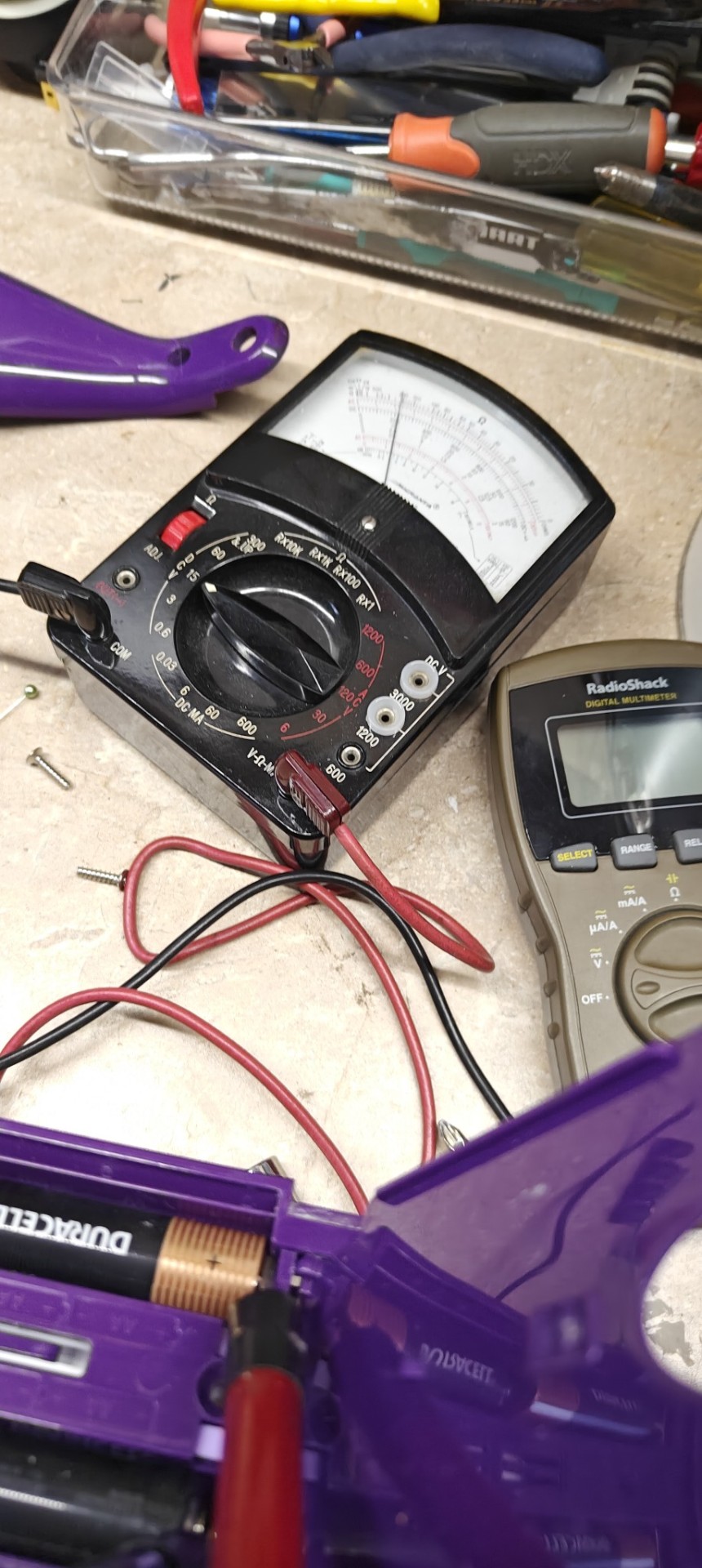
Tale of two vintage Radio Shack multimeters, a digital one from the 90s and another analog one probably 20 years older.
Trying to debug what is wrong with our Swiffer (tm) electric mop, which only goes click now instead of bzzz when you pull the trigger. My digital meter was going crazy with strange readings causing me to take more of this thing apart till I realized the 9v battery in it was probably low and causing it to act strange.
Not having a spare 9v battery, Hauled out this analog meter which in theory probably also has a dead battery in it, but it's only for the ohmmeter and the voltmeter is happy as a clam and instantly told me what I needed to know.
I'll get a new battery for the DVM... But I think I'm much more likely to reach for the analog meter. Not only is it nostalgic for me from my youth but it's actually still better in a lot of ways
42 notes
·
View notes
Text

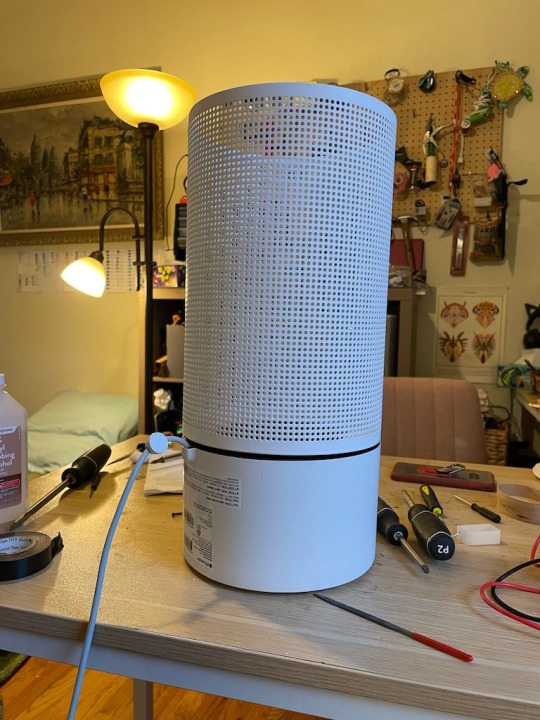
Kimchi (left) may or may not have thrown up on @fishteriously's air purifier (right) and killed it. Either way, it was dead and out of warranty, so we grabbed a multimeter and pried it open.
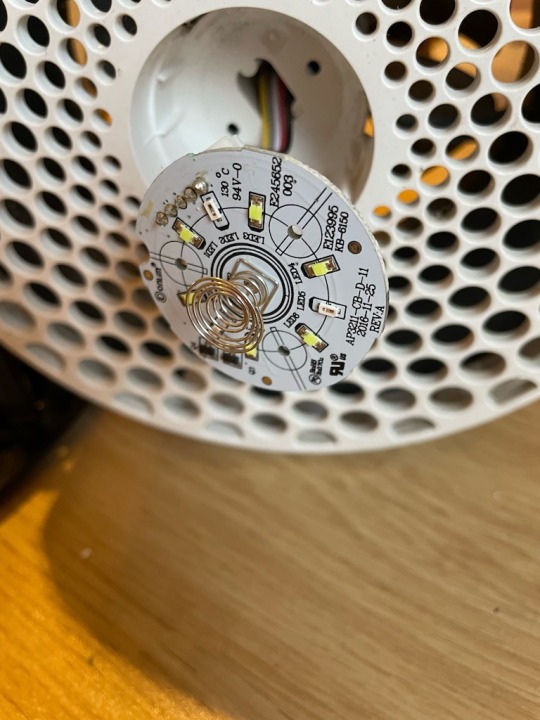
Ok so, the 12V power supply was working, regulated 5V power was getting where it was supposed to go, all the cables were secure and I couldn't find any shorts, but the thing was still dead. Also there was a mysterious brown goo all over it (mostly wiped off in this image).
Now, I'm a mechanical engineer, not an electrical engineer. But from what I understand, this state – where the power is good, but nothing is happening and there's something gross on it – is known as "turbo fucked."
But like, okay, once you get rid of all the bells and whistles such as "a user interface" and "selectable speed" and "digital electronics," an air purifier is just a fan, a cowl, and a filter, right? All analog components. There are plenty of places here to tap 5V power, so if I disconnect the microprocessor entirely, grab a jumper wire, and short 5V directly into the PWM input...

lol. lmao. It spins.

There we go! All put back together and working like a charm. I mean, the LED's and computer aren't connected to anything, but the fan is going and it purifies the air just fine.
I didn't like the look of the dead pcb sticking out of the top. But the wire cutters were on the other side of the room, and I hurt my fingernail last time I futzed with the ribbon cable...

Perfect. Good as new.
100 notes
·
View notes
Text
Finally...
I was looking for a really good shortwave receiver for at least a decade -an old tube equipped one of course. The problem getting one nowadays is that they were only produced in small numbers half a century (or more) ago, since then most are scrapped, botched, altered or corroded cause of bad storage -or all together. So if you have the chance getting one today you most likely will buy a 'construction site', needing hundreds of working hours for restoring it in a good working condition.
But after a looong search finally i had real luck. A big wooden crate was delivered on a pallet.

In this crate was one of the -for my opinion- ugliest shortwave receivers ever built, but at the same time also one of the best ones: a Rohde + Schwarz EK07.
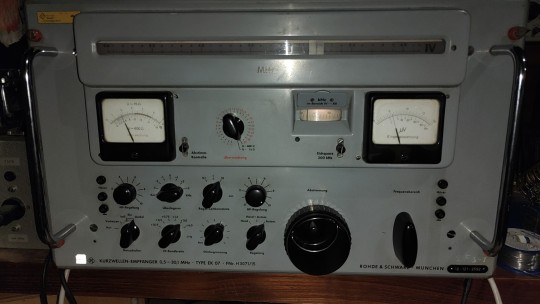
Built in 1958 this one was a storage unit from the German Army. Well stored, regularly maintained and serviced, not altered, not botched, never used. So it is in nearly mint condition. It wasn't cheap but getting my hands on this was just sheer luck. Without doing anything: it's in perfect working order. No potentiometer, no switch crackles, every tube checks new -of course you can check all the tubes in the radio itself without removing them.
The manufacturer is more known for it's precision Lab-Equipment and less for it's shortwave receivers. This is also because their receivers weren't consumer or amateur gear, this was pro gear by any means. They were used in applications like coast guards or military surveillance and such. Always things where equipment costs doesn't matter -only the outcome. So back in 1958 when this unit was manufactured you could buy at least two brand new cars for the same amount of money. In exchange for this you got a masterpiece of german engineering and craftsmanship -and also an electro-mechanical nightmare if anything fails and you're not absolutely familiar with it's guts.
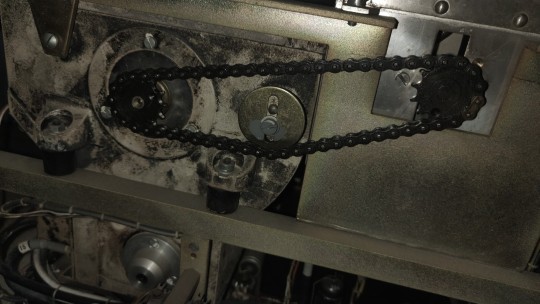
Fancy? No, there's absolutely nothing fancy on these. These are absolute workhorses, designed for doing an important job 24/7/365 for decades. Just take a look to that bandswich gear in the photo above. How often you have to switch over the bands until this would be worn out? Millions and Millions of times... And nope: this dark residues at that drum on the left and box below isn't mold or such. These are completely silver plated so it's just the darkened silver.
As you may see, most of the structural parts are made of die-cast and aluminum, so from the materials used it's relatively light weight. But all that built-in sturdiness and shielding adds up to staggering 147lbs/67kg. It's only a receiver, not a transmitter or a power amplifier.
Tubes... and more tubes
If you're not familiar with tube radios: your average AM (and shortwave) Radio from the 50's or 60's used 4 tubes (without the rectifier if this was a tube). Your trusty Hammarlund or Yaesu shortwave receiver from that time would have somewhat from 8 to 12 tubes -and these were quite good and sensitive receivers! This Rohde + Schwarz counts 28 tubes.

Some tubes here, some there, all fully shielded. But why the hell that much? The answer is quite simple: stability. On every count. Constant and stable gain over all bands and for a looong service time, stunningly stable VFO frequencies and all that stuff. No, they used no consumer tubes like in your TV or such. All of them are out of the 'commercial'-tube-series with a guaranteed service life of at least 10000 hours like in every aircraft of that time or such. Failing was not an option, this HAD to work.
Speaking about stability and accuracy:
this of course isn't digital stuff -it's purely analog. In the pictures below you can see the dials. Just add both frequencies and you know where you are -here on 29.630MHz or 29630kHz.
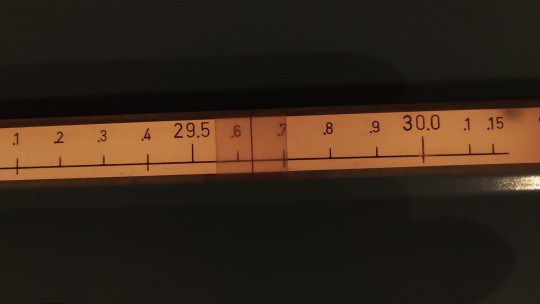

As you see: your readout is easily accurate down to less than 500Hz. So you can read at least 500Hz out of 29630000Hz. With other words the accuracy of your readout is 0.001687% in this case. Your average modern digital multimeter would be proud if it came only near to this 65 year old contraption.
Of course that large dial in the picture on the left isn't the only one. There are 12 of 'em, mounted on a drum and rotating according to the selected band. Giving you a simple S-Meter like in other shortwave receiver was of course also not possible.

Instead they provided you with a Voltmeter which displays directly the input voltage at the antenna input -and the threshold voltage for the 'Squelch' (if you have set that) which isn't a normal squelch. If activated it doesn't cut your Audio, it reduces the Gain instead with a settable time constant, so it acts more like a active noise cancelling between any signal -also between any dash and dot if you're receiving CW (Morse Code). Besides that you can choose your IF-Passband between 150Hz and 12kHz, have a absolutely stable BFO, a good Envelope Detector for AM-Reception and a perfect Audio Stage - that's all.
Speaking of the Audio Stage: 2W undistorted output power from a single end class-A is more than you need with a good speaker. McIntosh ® would call that circuit 'Unity Coupled', further a E88CC for the Audio-Preamp. We're talking about an Shortwave Radio, not an 'High-End' Audio Amplifier. Wanna take recordings of what you hear? No problem: here's your Line-Output, symmetric, 600 ohms, transformer coupled and with +10dBm (if you want) and in accordance to all Studio-Standarts. Sound quality for AM Broadcasts? With a passband switchable up to max. 12kHz for the IF better than the majority of stations can provide.
Precise?
So far so good, but what's about the heart of every shortwave receiver: the Oscillator or VFO? How stable and precisely does it beat after 65 years?
In your trusty -and quite good- Hammarlund or Yaesu amateur Radio from these days the VFO usually is equipped with two tubes: the Oscillator itself and the buffer amplifier -both sometimes also united in one bulb. If i hadn't lost track here they used 12 -and tons of other stuff. So that frickin VFO has a component count which is easily about the order of a complete shortwave receiver.
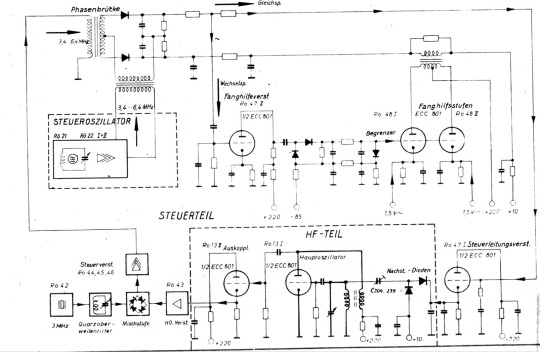
What the hell is all that stuff about -and wtf they had for breakfast back then? The answer is again simple: precision and stability.
As i said: this thing is 65 years old and i touched nothing. Of course I checked how much it's 'off' in terms of the frequency. After warming up for 20 Minutes i checked it every 1000kHz from the bottom to the top of its range. It was a bit different between all points, at some less than 50Hz and about 1kHz worst case.
My Lab-Equipment is quite good and precise, but for these low errors the tolerances of the measuring equipment has absolutely taken into account. So i made a separate measurement only for 10MHz -with the aid of a frequency standard sourced from an atomic clock. So this was 'the real thing'. After warming up for an hour i measured for 15 Minutes. The deviaton was between -717 to -722Hz. Including the error of the dial. This means frickin' 71.7...72.2ppm. PPM -parts per million! 65 years after manufacturing.... Just absolutely stunning -and with what freaking kind of equipment they had calibrated this back then??? Just have in mind: this is pure analog goodness, not a modern PLL. How the f***k they got there? Here's the clear link between a manufacturer of high-grade Lab Equipment and a shortwave receiver. I'm just stunned over the knowledge of the engineers who designed that circuit back then and the precision this was built.
All without doing anything and all it's original capacitors. Yap, i could realign that but tbh it's just wayyy to less been worth the effort. So it will stay as it is.
Nope,
you're not provided with that fancy stuff your new digital or SDR may have on board. There's no notch filter, no panoramic display -not even SSB! Why the hell they just 'forgot' all these things? The answer is easy: it's modular. The EK07 is just the 'mainframe', everything else you wanted to have can be added as external components you had to buy separately -also for tons of money of course.
Wanting SSB? Just add this:

35kg/77lbs and 18 Tubes more -to mention it's also a synchronous detector for AM is not worth the effort. Panoramic display, digital frequency counter, Teletype Adaptor, a remote control for controlling that beast over a telephone line? FM? Diversity reception?? No problem, you had just buy it. Everything of course with the same standards for precision and build quality.
The outcome...
Yea, i spent a good amount of money getting this -but in my opinion it was worth every dime. I wanted a good tube receiver and i got a really good one. Compared to upper class modern Radios it's still a very good radio. So the only thing I have to add is an external SSB/AM-Synchronous Detector. The originals are nearly impossible to get today, so i decided to build one. It's on the way and i will give you the results later. So stay tuned...
5 notes
·
View notes
Text
Story time!
So our professors are mostly engineers (others are either mathematicans or physicians) so they have experience big time in the field.
For our analogical electronics lab we were working on the circuit of chargers (transformer + diode wheatstone bridge) and one of the components was faulty and considering both the wheatstone bridge and transformer were made by component we needed to start trouble shooting one by one
so we took 10 minutes of plugging unplugging then testing til we reached our wheatstone bridge and tested the second diode
our professor notices us struggling and wonders if we were doing alright then he realizes we are testing for voltage drop between component and you know that moment when nerds in anime go: " (readjust glasses)"
We just saw the experience gap when he switches the multimeter to measuring intensity and told us: "you can keep testing all components until intensity is zero without unplugging this will be where our problem is" and in 2 minutes he figures out what we would have taken more than 10 minutes to find without figuring ourselves and since this day I will forever remember that technique our prof is. It's the exact moment when the mentor shows his full power to the student in media

7K notes
·
View notes
Text
Exploring the Top Electronic Lab Equipment Suppliers in Indore
Indore, a rapidly growing hub for education, electronics, and industrial innovation, has become home to several advanced technological ventures. Among its rising sectors, electronic lab equipment suppliers in Indore play a pivotal role in equipping educational institutions, R&D centers, and industrial labs with state-of-the-art instruments. Whether you're setting up a new electronics lab or upgrading your testing infrastructure, the city offers a wide range of high-quality equipment suited for various applications.

Why Indore for Electronic Lab Equipment? Indore is recognized for its educational excellence and industrial dynamism. With leading universities, engineering colleges, and a thriving manufacturing base, the demand for lab equipment is constantly on the rise. This has led to a surge in reliable electronic lab equipment suppliers in Indore, offering everything from basic testing tools to advanced embedded systems trainers. Choosing local suppliers ensures better service, faster delivery, and hands-on technical support. Additionally, many suppliers in Indore offer customized training solutions and product demonstrations, making them ideal partners for institutions and companies alike. Types of Products Offered by Electronic Lab Equipment Suppliers in Indore The range of products offered by electronic lab equipment suppliers in Indore is vast and designed to meet the needs of diverse fields. Here’s a breakdown of the major product categories:
Basic Electronics Lab Equipment Power supplies, function generators, and multimeters
Breadboards and prototyping tools
Oscilloscopes and frequency counters
Embedded Systems & Microcontroller Kits Arduino and ARM-based development boards
8051 and PIC microcontroller kits
Training modules for IoT, robotics, and automation
Communication Systems Analog and digital communication trainers
Fiber optic kits
Satellite communication systems
Electrical Engineering Labs Electrical machines, circuit labs, and power electronics kits
Control system simulators
Power system protection and analysis kits
Renewable Energy & Green Tech Solar PV and wind energy trainers
Smart grid simulation units
Energy auditing and monitoring tools
These offerings demonstrate the depth and versatility of electronic lab equipment suppliers in Indore, catering to both conventional and modern curriculum requirements. Key Advantages of Choosing Indore-Based Suppliers Working with electronic lab equipment suppliers in Indore comes with several benefits: Local Support and Service: Having a local presence allows suppliers to offer quick installation, training, and troubleshooting services.
Cost-Effective Solutions: Indore-based vendors often offer highly competitive pricing without compromising on quality.
Customization Capabilities: Suppliers can tailor lab kits based on the institution’s syllabus or industrial training requirements.
Strong After-Sales Support: Dedicated service teams ensure minimal downtime in case of equipment issues.
These factors make the city’s suppliers ideal for long-term academic and industrial partnerships. Applications in Education and Industry The demand for lab equipment from electronic lab equipment suppliers in Indore spans across sectors. Here’s how different industries and institutions benefit: Colleges & Universities: Equip students with hands-on experience in analog, digital, and embedded systems through robust lab setups.
Research Institutions: Perform advanced experimentation and prototyping with precision electronic instruments.
Technical Training Institutes: Offer practical learning environments with real-world tools and scenarios.
Manufacturing Industries: Use high-end lab tools for PCB testing, automation controls, and sensor integration.
Startups & Innovation Labs: Support R&D through rapid prototyping and testing solutions.
The flexibility and reach of Indore’s suppliers make them valuable contributors to academic growth and technological advancement.
Taking these aspects into account ensures that your lab setup is efficient, scalable, and future-ready. Future Trends in Lab Equipment With the rise of Industry 4.0 and smart technologies, electronic lab equipment suppliers in Indore are also evolving. Expect to see integration of: IoT-enabled lab kits
Cloud-based learning platforms
AI-assisted training modules
Virtual simulation labs
These advancements are helping bridge the gap between theoretical knowledge and real-world skills, making technical education more interactive and industry-aligned. Conclusion As education and industry continue to evolve, the need for practical, hands-on learning tools becomes more crucial. Electronic lab equipment suppliers in Indore have stepped up to meet this demand by offering a diverse, high-quality range of lab products tailored for electronics, communication, automation, and renewable energy. By choosing a local supplier in Indore, institutions and businesses gain not only access to top-notch instruments but also technical guidance, training support, and affordable solutions. Whether you're building a new lab or upgrading an existing one, the right supplier in Indore can help you drive innovation, enhance skill development, and stay ahead in today’s competitive landscape.
0 notes
Text
The Building Blocks of Electrical Engineering: What Every Student Should Master
A solid grounding in the fundamentals is essential for every aspiring electrical engineer. Mastery of these core concepts not only enables effective problem-solving and innovation but also forms the basis for all advanced studies and professional success in the field.
Core Principles and Laws
Ohm’s Law: This fundamental law relates voltage, current, and resistance in a circuit. It states that the voltage across a conductor is directly proportional to the current flowing through it, provided the physical conditions remain constant (V = I × R).
Kirchhoff’s Laws:
Kirchhoff’s Current Law (KCL): The total current entering a junction equals the total current leaving it.
Kirchhoff’s Voltage Law (KVL): The algebraic sum of all voltages around any closed loop in a circuit is zero.
Network Theorems: Thevenin’s and Norton’s theorems are essential for simplifying complex circuits and analyzing their behavior.
Basic Electrical Quantities
Current (I): The flow of electric charge, measured in amperes. It is the movement of electrons through a conductor.
Voltage (V): The electrical potential difference that drives current through a circuit, measured in volts.
Resistance (R): The opposition to current flow, measured in ohms. It depends on the material, length, and cross-sectional area of the conductor.
Power (P): The rate of energy transfer in a circuit, calculated as P=IVP=IV, measured in watts.
Circuit Elements and Analysis
Passive Elements: Resistors, capacitors, and inductors, which absorb or store energy but do not generate it.
Active Elements: Voltage and current sources that supply energy to the circuit.
Series and Parallel Circuits: Understanding how components behave in series (same current, voltage divides) and parallel (same voltage, current divides) is crucial for circuit analysis.
Star-Delta Transformation: A technique for simplifying complex resistor networks.
Types of Circuits
DC Circuits: Circuits powered by a constant direct current source. Analysis involves the steady-state behavior of resistors, capacitors, and inductors.
AC Circuits: Circuits powered by alternating current sources. Analysis includes understanding reactance, impedance, and phase relationships.
Single-phase and Three-phase Systems: Essential for understanding power distribution and the operation of industrial equipment.
Electromagnetism and Machines
Electromagnetic Principles: Understanding magnetic fields, flux, and electromagnetic induction is foundational for working with motors, generators, and transformers.
Transformers: Devices that transfer electrical energy between circuits through electromagnetic induction. Key for voltage conversion and power distribution.
Motors and Generators: Machines that convert electrical energy to mechanical energy (motors) and vice versa (generators). Knowledge of their principles and operation is vital.
Measurement and Instrumentation
Measuring Instruments: Familiarity with devices like voltmeters, ammeters, and multimeters is essential for practical circuit analysis and troubleshooting.
Power Factor: Understanding and improving power factor is important for efficient energy use in AC systems.
Mathematics and Physics Foundations
Mathematics: Proficiency in calculus, trigonometry, and differential equations is necessary for modeling and analyzing electrical systems.
Physics: Concepts from electromagnetism and basic mechanics underpin much of electrical engineering theory and practice.
Digital and Analog Systems
Analog Circuits: Continuous signal processing; involves resistors, capacitors, inductors, and transistors.
Digital Circuits: Discrete signal processing; involves logic gates, memory systems, and microcontrollers.
Embedded Systems: Integration of hardware and software for intelligent electronic solutions.
Practical Skills and Lifelong Learning
Circuit Design and Simulation: The Ability to design, analyze, and simulate circuits using modern tools is crucial for both academic and professional success.
Project-Based Learning: Hands-on experience through projects enhances understanding and develops problem-solving skills.
Continuous Learning: The rapid evolution of technology in electrical engineering demands ongoing education and adaptability.
Concept/Area
Why It’s Essential
Ohm’s Law, KCL, KVL
Foundation for circuit analysis and design
Circuit Elements
Understanding the behavior and function of components
AC/DC Circuits
Basis for power systems, electronics, and signal processing
Electromagnetism
Underpins the operation of machines, transformers, and communication systems
Measurement & Instrumentation
Enables accurate analysis and troubleshooting
Mathematics & Physics
Provides tools for modeling and solving engineering problems
Analog & Digital Systems
Core to modern electronics and embedded systems
Lifelong Learning
Ensures relevance and adaptability in a fast-evolving field
Summary Table: Key Concepts and Their Importance
Conclusion
Mastering these fundamentals equips electrical engineering students to analyze, design, and maintain the systems that power modern society. Arya College of Engineering & I.T. is the best college of Jaipur which has a deep understanding of these core concepts fosters innovation, supports professional growth, and prepares students for the diverse challenges of an ever-evolving field.
0 notes
Text
From Breadboards to Breakthroughs: Hands-On Projects to Improve Your EE Skills

From Breadboards to Breakthroughs” encapsulates the journey of an aspiring electrical engineer as they evolve from basic circuit experiments to advanced, real-world engineering projects. Hands-on projects are essential for building practical skills, reinforcing theoretical knowledge, and preparing for professional challenges. Below is a guide to project-based learning that can help you improve your electrical engineering (EE) skills at every stage.
Beginner Projects: Building Foundations
Simple LED Circuit
What you learn: Basic circuit design, current and voltage concepts, use of resistors and LEDs.
Tools: Breadboard, jumper wires, resistors, LEDs, battery.
Battery Tester:
· What you learn: Measuring voltage and current, basic instrumentation, and safety practices.
Water Level Indicator
What you learn: Sensor integration, simple logic circuits, and practical applications.
Logic Gates and Digital Circuits: What you learn: Boolean logic, digital circuit fundamentals, and troubleshooting.
DIY Switch Circuits: What you learn: Circuit switching, input/output devices, and practical wiring.
Intermediate Projects: Expanding Your Skills
Infrared Security System: What you learn: Sensor-based security, signal processing, and system integration.
Digital Voltmeter: What you learn: Instrumentation, analog-to-digital conversion, and measurement accuracy.
Solar Charger: What you learn: Renewable energy concepts, power management, and circuit protection.
Motor Control Circuits
What you learn: Driving motors, pulse-width modulation (PWM), and power electronics.
Heart Rate Monitor: What you learn: Biomedical instrumentation, sensor interfacing, and signal filtering.
Advanced Projects: Real-World Breakthroughs
Smart Home Automation System: What you learn: IoT, wireless communication (Bluetooth, Wi-Fi), and system integration.
Wireless Power Transfer System: What you learn: Inductive coupling, resonant circuits, and energy efficiency.
Dual Axis Solar Power Tracker: What you learn: Mechatronics, sensor feedback, and renewable energy optimization.
Smart Energy Meter: What you learn: Real-time data monitoring, wireless communication, and energy management.
DIY Quadcopter or Drone: What you learn: Embedded systems, motor control, wireless communication, and robotics.
Why Hands-On Projects Matter
Resume Building: Practical projects demonstrate your skills to potential employers and can help you land internships or jobs
Theory Application: Projects bridge the gap between classroom learning and real-world engineering challenges.
Skill Discovery: Experimenting with different projects helps you identify your interests and strengths.
How to Get Started
Gather Basic Tools: Invest in a quality breadboard, jumper wires, resistors, capacitors, LEDs, and a multimeter.
Start Simple: Begin with basic circuits and gradually tackle more complex projects as your confidence grows.
Use Online Resources: Take advantage of tutorials, simulation tools, and open-source project guides.
Join Maker Communities: Engage with online forums, local maker spaces, and engineering clubs for support and inspiration.
Document Your Work: Keep a project journal, take photos, and share your progress on platforms like GitHub or LinkedIn.
Conclusion
Arya College of Engineering & I.T. is one of the best engineeering college in Jaipur, which is progressing from breadboard experiments to advanced engineering projects is a transformative process that builds both technical expertise and problem-solving confidence. By systematically advancing through beginner, intermediate, and advanced projects, you will develop a robust skill set that prepares you for the challenges and opportunities of a career in electrical engineering.
Source: Click Here
#best btech college in jaipur#top engineering college in jaipur#best private engineering college in jaipur#best engineering college in rajasthan#best btech college in rajasthan#best engineering college in jaipur
0 notes
Text
0 notes
Text

1 note
·
View note
Text

Branded True RMS Digital Multimeter and Analog Multimeters – TOMSON ELECTRONICS
Explore branded True RMS digital multimeters and analog multimeters at Tomson Electronics. Get accurate measurements and reliable performance for your electronic projects. Shop now for top-quality multimeters from trusted brands.
1 note
·
View note
Text
Instrument Rental for Engineers: Choosing the Right Electrical Measuring Devices
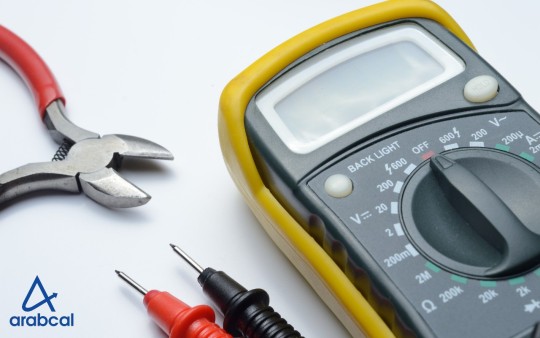
Electrical measurement devices are vital for assessing, tracking, and evaluating electrical circuits and systems. These tools are key to ensuring the safety, precision, and optimal performance of electrical operations across industries such as construction, manufacturing, and electrical engineering. For top-quality electrical measuring instruments, Arabcal provides reliable and accurate tools to meet all your measurement needs, ensuring superior performance and safety in every application.
This blog will guide you through various types of electrical measuring devices, including the multimeter, ammeter, voltmeter, and wattmeter
Let’s explore their practical uses and learn how to operate these measuring devices properly to ensure precise results.
1. Multimeter
Multimeters are among the most widely utilized electrical testing instruments in labs. They are capable of measuring various electrical parameters such as voltage, current, and resistance. These devices are frequently employed for diagnosing issues and performing upkeep on electrical systems.
2. Ammeter
An ammeter is used to measure the flow of direct or alternating current within an electrical circuit. The measurement is expressed in Amperes (A). Ammeters are installed in series with the circuit to ensure accurate readings. They are designed with very low resistance to permit a high current flow. Ammeters are capable of detecting a wide spectrum of current levels.
When the current to be measured is in milliamps or microamps, specialized instruments called microammeters or milliammeters are used. There are two primary types of ammeters – analog and digital. Analog ammeters display the current using a pointer and scale, while digital ammeters show the reading on a digital screen.
3. Voltmeter
A voltmeter is used to measure the voltage or electrical potential difference between two points in an electrical circuit. Voltage is expressed in volts. Voltmeters are generally connected in parallel with the component or circuit being measured and are designed with very high resistance to limit the current flow through the circuit.
Commercial voltmeters typically use an electromechanical system where the current is converted into voltage before being measured. In contrast, electrostatic voltmeters directly measure the voltage. Similar to ammeters, voltmeters come in two types – analog and digital.
4. Wattmeter
A wattmeter is used to measure the power or the rate at which energy is consumed in an electrical circuit. Power is expressed in watts (W). Wattmeters are commonly employed in three-phase systems to measure both apparent and real power in a circuit. They are also useful for assessing power supply efficiency and calculating energy costs.
Wattmeters are connected in such a way that they measure both the current and voltage in the circuit, then compute the power using the formula P = VI (where P is power, V is voltage, and I is current). These devices are often used to track the power consumption of appliances and evaluate the output power from generators and other energy sources.
How to Select the Right Electrical Instrument?
It’s also crucial to take into account the measurement range that the instrument can handle. Some devices offer a broad range of measurements, while others are limited to a narrower scope. Furthermore, the accuracy of the instrument is an important factor. The greater the accuracy, the more precise the readings will be.
It’s essential to remember that to achieve precise measurements, the appropriate range or sensitivity of the meter should be chosen. For instance, using a meter with a low range to measure a high current will result in inaccurate readings. Similarly, using a meter with a high range to measure a low voltage will also lead to unreliable results.
When operating these instruments, it's crucial to adhere to proper safety guidelines to safeguard both yourself and the equipment. This involves making sure the circuit is powered off before connecting any devices, and wearing the correct personal protective gear, such as rubber gloves and safety goggles.
Conclusion
In summary, electrical measurement devices are crucial for maintaining the safe and effective functioning of electrical systems. By familiarizing yourself with the specific features and functions of these instruments, you can make a well-informed choice when selecting the right tool for your needs. With a broad range of options available, including voltmeters, ammeters, wattmeters, and clamp meters, there’s an electrical measuring instrument suited to your particular requirements. For reliable instrument rental UAE, Arabcal offers top-quality tools and equipment for all your electrical measurement needs.
#tester equipment supplier uae#megger service center#instrument and equipment supplier in uae#iso 17025 accredited calibration company in uae#calibration#biomedical test equipment#asset management in uae
0 notes
Text
5 Common CNC Router Controller Issues and How to Fix Them

In the world of modern manufacturing, CNC routers are indispensable for achieving precision and efficiency. However, even the most advanced machines are vulnerable to technical glitches—particularly with their controllers. A CNC router controller is essentially the command center that translates software instructions into physical movement. When something goes wrong here, it can bring your entire operation to a halt.
This article dives deep into the five most common CNC router controller issues, how to troubleshoot them effectively, and what you can do to prevent them in the future. Whether you're running a small shop or managing a high-volume production line, these insights will help keep your machine in top shape.
1. Controller Won’t Power On
You hit the switch—and nothing. No lights, no motion, no signs of life.
Why It Happens:
Blown fuses or breakers.
Loose or disconnected power cables.
Malfunctioning power supply unit (PSU).
Incorrect input voltage or surge damage.
How to Fix It:
Check and replace any blown fuses.
Make sure power cords are firmly connected and not frayed.
Test the PSU with a multimeter to verify correct output voltage.
Use a voltage regulator or surge protector to prevent future damage.
Pro Tip: Label your power supply connections clearly during setup. It makes troubleshooting faster and easier.
2. Freezing or Crashing During Jobs
Midway through a cut, your router suddenly locks up. Job ruined, material wasted.
Why It Happens:
Controller overheating due to poor airflow.
Bugs or incompatibility in the firmware/software.
Memory overload from excessive G-code complexity.
EMI (electromagnetic interference) or loose data connections.
How to Fix It:
Keep the controller clean and properly ventilated.
Ensure all software and firmware are updated to stable versions.
Break up large files into smaller toolpaths.
Use shielded cables and ensure proper grounding to eliminate EMI.
Maintenance Hack: Consider using CNC Control Retrofits that come with improved cooling and processing power to reduce these occurrences significantly.
3. Axis Movement Not Working
If your CNC router won’t move along the X, Y, or Z axis, you’re essentially grounded.
Why It Happens:
Stepper driver failure.
Motor or cable disconnects.
Faulty G-code or coordinate settings.
Loose or stripped motor couplings.
How to Fix It:
Double-check driver and motor connections.
Test drivers individually by swapping them between axes.
Inspect and fix any loose mechanical parts.
Review your CAM setup to ensure proper motion commands are being sent.
Upgrade Tip: If your machine frequently suffers from axis issues, consider CNC Control Retrofits that upgrade your stepper systems to more reliable and powerful servo motors.
4. Controller Doesn’t Connect to Computer
You plug in the USB cable and nothing happens—no connection, no control.
Why It Happens:
Outdated or missing drivers.
Cheap or damaged USB cables.
Wrong COM port selected in software.
Firmware and software version mismatch.
How to Fix It:
Install the correct drivers (often CH340 or FTDI).
Replace USB cable with a short, shielded one.
In your control software, manually select the correct COM port.
Verify the firmware on your controller is compatible with your software version.
Pro Note: Avoid USB hubs. Connect directly to your PC's port whenever possible.
5. Spindle Won’t Start or Has Speed Issues
Spindle problems can cause major setbacks—especially when cuts rely on consistent speeds.
Why It Happens:
No PWM or analog control signal.
Misconfigured spindle driver or VFD.
Incorrect G-code spindle commands (e.g., M3, S1000).
Motor overload or faulty wiring.
How to Fix It:
Ensure all spindle control wiring is secure and accurate.
Verify VFD settings align with your spindle motor specs.
Use test commands (M3 S1000, M5) to isolate the problem.
Test spindle motor directly to confirm it’s functional.
Expert Insight: CNC Control Retrofits often include improved spindle control systems, allowing for smoother and more reliable speed regulation across various materials.
Bonus: Preventing CNC Controller Problems
Fixing problems is good. Preventing them is better. Here’s how:
Regular Cleaning: Dust buildup is the silent killer of electronics.
Firmware Updates: Always run the most stable versions—not betas.
Cable Management: Keep power and signal wires separated.
Surge Protection: Always use voltage regulators or UPS systems.
Monthly Checklist: Schedule a 15-minute inspection every month to check connections, clean filters, and back up your machine settings.
Conclusion
CNC routers are amazing tools—but only when the controller is functioning flawlessly. Whether you're dealing with power issues, motion problems, or connectivity failures, the key is understanding what’s going wrong and how to fix it efficiently.
As we've seen, many common problems can be traced back to simple issues like loose wires or outdated software. But if you're constantly struggling with performance or compatibility, it's worth considering CNC Control Retrofits to upgrade aging systems with modern, more reliable hardware.
By applying the strategies in this guide, you'll not only be ready to fix issues quickly, but you'll also be in a strong position to prevent future downtime, maximize efficiency, and get the most out of your CNC investment.
1 note
·
View note
Text
Galaxy Majestic Stainless Steel Case Watch
In the realm of timepieces, the Galaxy Majestic Stainless Steel Case Watch stands as a testament to refined craftsmanship and timeless elegance. Designed for the modern man who values both form and function, this watch seamlessly blends classic aesthetics with contemporary features.
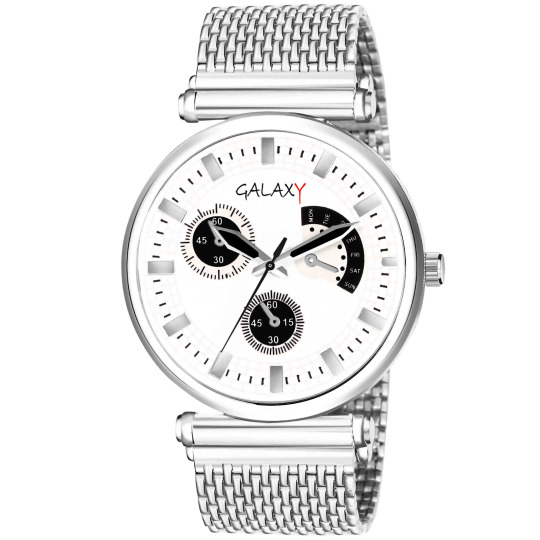
Design and Aesthetics
The Galaxy Majestic watch boasts a sleek, silver-tone stainless steel case that exudes sophistication. Its round design is complemented by a pristine white dial, offering a clean and minimalist look suitable for various occasions. The dial is adorned with multiple sub-dials, including day, date, and 24-hour indicators, enhancing both its functionality and visual appeal. Completing the design is a matching silver mesh bracelet, providing a comfortable fit and a seamless extension of the watch's elegant profile.Galaxy Watches
Specifications at a Glance
Model Code: GRTGCSS549
Case Diameter: 36mm
Case Color: SilverBajaj Mall
Case Material: Metal
Dial Diameter: 37mmGalaxy Watches+2Bajaj Mall+2Galaxy Watches+2
Dial Color: White
Strap Color: SilverBajaj Mall
Strap Width: 22mm
Strap Material: Metal ChainBajaj Mall+3Samsung+3Galaxy Watches+3
Clasp Style: Folding
Crystal Type: 3D
Display Type: Analog (Note: MultiMeter functions are non-operational)
Mechanism: QuartzGalaxy Watches+5Galaxy Watches+5Samsung+5
Occasion: Everyday EssentialsBajaj Mall
Style: Minimalist
Functionality and Performance
At the heart of the Galaxy Majestic watch is a reliable quartz mechanism, ensuring precise timekeeping for daily wear. While the sub-dials enhance the watch's aesthetic appeal, it's essential to note that the MultiMeter functions are non-operational, serving a decorative purpose. This design choice maintains the watch's sleek profile without compromising its minimalist charm.
Versatility for Every Occasion
Whether you're heading to a business meeting, a casual outing, or a formal event, the Galaxy Majestic watch is designed to complement a wide range of attire. Its minimalist style and neutral color palette make it a versatile accessory, seamlessly fitting into both professional and social settings.
Care and Maintenance
To ensure the longevity and pristine condition of your Galaxy Majestic watch:
Avoid Moisture: Keep the watch away from water and moisture to prevent potential damage.
Handle with Care: Avoid rough usage or impacts that could scratch or dent the watch.
Regular Cleaning: Gently wipe the watch with a soft cloth to remove any dirt or smudges, maintaining its shine and clarity.
Affordability Meets Luxury
Priced at ₹599, the Galaxy Majestic Stainless Steel Case Watch offers an affordable entry into the world of luxury timepieces. Its combination of elegant design, functional features, and accessible pricing makes it an attractive choice for those seeking quality without breaking the bank.
About Galaxy Watches
Galaxy Watches is a contemporary brand catering to millennials and Gen Z, offering minimalistic, unique, and trend-setting global styles at affordable prices. The brand believes in the philosophy of "Less is More," focusing on clean lines, classic colors, and simplicity. Inspired by international trends and high street styles, Galaxy Watches strives to create timeless designs that prioritize both comfort and functionality.
Conclusion
The Galaxy Majestic Stainless Steel Case Watch embodies the perfect blend of classic design and modern sensibility. Its elegant aesthetics, reliable performance, and versatile appeal make it a worthy addition to any gentleman's collection. Whether you're a seasoned watch enthusiast or someone looking to invest in their first quality timepiece, the Galaxy Majestic watch promises to be a companion that stands the test of time.
For more details or to make a purchase, visit the official Galaxy Watches website.
📩 Follow us on Instagram for the latest collections: @galaxywatches.official
For inquiries, contact: 📍 Address: S 17, Bhaktinagar Station plot DD Enterprise, near Bank of Baroda, Rajkot, Gujarat, India 📧 Email: [email protected] 📞 Phone: +918686595920
For more information, visit their website: www.galaxywatches.in
To stay updated with the latest posts, follow us on social media:
📸 Instagram- https://www.instagram.com/galaxywatches.official/
📘 Facebook- https://www.facebook.com/galaxywatches.official
🐦 Twitter (X)- https://x.com/GalaxyWatches/
🔗 Linkedin- https://www.linkedin.com/in/galaxywatches/
📌 Pinterest- https://in.pinterest.com/galaxywatches/
🧵 Thread- https://www.threads.net/@galaxywatches.official
❗ YouTube- https://www.youtube.com/@galaxywatches
GALAXY WATCHES
Contact- +91 86865 95920
Digital Partner:
TVM INFOSOLUTIONS PVT LTD
Contact: TVM Info Solutions Pvt. Ltd.
+91-9004590039
Follow us on Social Media
🌐 Website
📸 Instagram
📘 Facebook
🔗 Linkedin
▶️ Youtube
0 notes